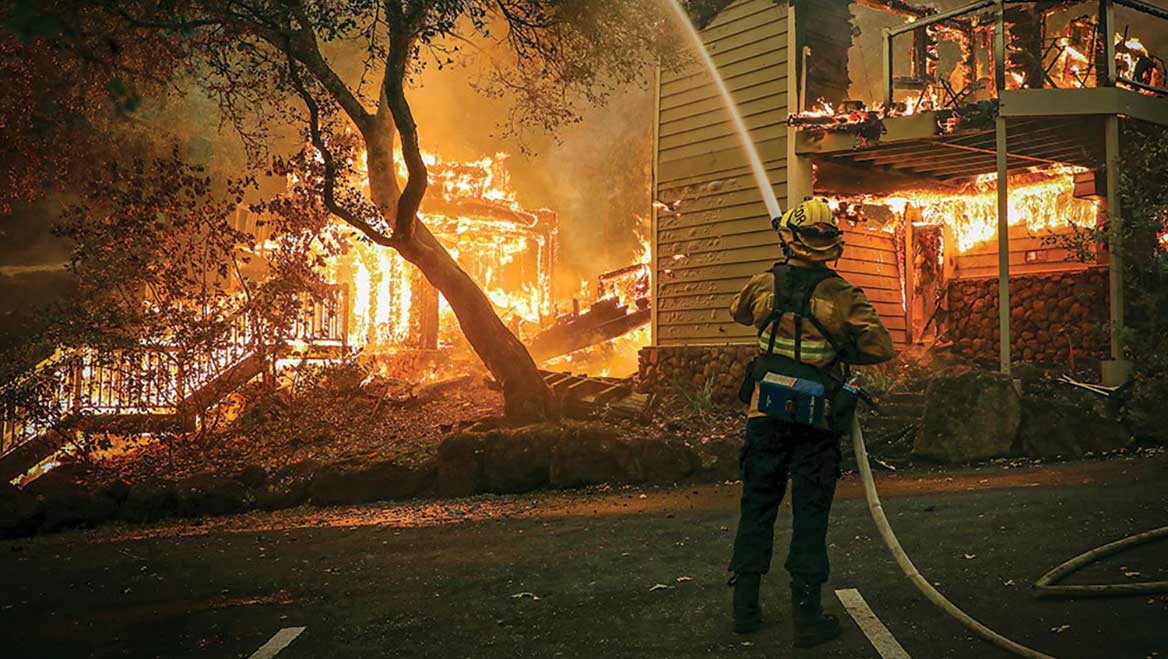Part of the Disruptors Series
Jan. 1, 2021
Buffalo Mayor Byron Brown declared two years ago that the city on the eastern shores of Lake Erie would be a "Climate Refuge City." Buffalo, the second-largest city in New York state, has seen its population steadily decline for decades as steel and heavy manufacturing activity dried up. But the mayor hopes its existing infrastructure and amenities — not to mention the cooler climate — could make Buffalo more attractive to those fleeing oppressive heat, vanishing shorelines, or other existential consequences of global climate change.
Nadine Marrero, AICP, Buffalo's director of planning and zoning, says Buffalo offers a lot for people looking for a more sustainable place to live.
"We can't ignore that Buffalo is located on a Great Lake, and the Great Lakes are probably the best protected fresh water source" in the country, she says. "We get a sunset over a Great Lake in Buffalo. It's pretty cool. Not a lot of cities that get that."
Potential residents might be attracted to its many parks designed by Frederick Law Olmsted, or its proximity to Canada. They might like visiting nearby ski resorts and enjoying a cold drink at one of its breweries. An airport and light-rail system make it easy to get around.
Most importantly, though, Marrero says, Buffalo is prepared to grow. The city totally revamped its zoning code three years ago in ways designed to encourage people to take advantage of the city's urban character. The changes make it easier to add density in residential areas and to increase flexibility for how to use industrial areas — especially the large, daylit factories that have long been abandoned. That's led to the revitalization of areas like the Larkin District, which is now home to law firms, banks, and apartments.
Buffalo already gained a few hundred residents from Puerto Rico after Hurricane Maria devastated the island in 2017. City officials hope the so-called "City of Good Neighbors" will reverse its population decline in the next decade. Part of making that happen, Marrero says, is attracting people displaced by climate change. That could be a significant population.
"The evidence is in. People are moving and have already moved," says Prisca Weems, principal of design firm FutureProof, who helped with recovery efforts after Hurricanes Katrina and Sandy. "Quite a lot of people have met their thresholds and are concerned because the most recent events have not been their first."
But experts caution that geography alone won't turn communities into receiver cities. Making that transformation, they say, will require communities to think about their own sustainability and capacity and prepare their existing residents for changes to come.

Firefighters work to put out a fire engulfing a hotel structure in St. Helena, California, in September 2020. Photo by Jim Wilson/The New York Times.
Millions of migrants on the move
Nearly one million Americans were displaced by disasters in 2019. That number is only expected to grow annually. Last year provided plenty of reminders as to why. Record-setting forest fires scorched much of the West and turned California's sunny skies a ghastly orange hue. The Atlantic Ocean produced 30 named storms last year, a new high. Eleven made landfall in the U.S.
More than 13 million could be forced to relocate by the end of the century because of sea level rise, according to research conducted by Matthew Hauer, a sociology professor at Florida State University. His projections indicate that Florida would be hit hardest, losing 2.5 million residents. Eight other states would lose people as well. Texas, on the other hand, stands to gain 1.5 million inhabitants.
But extreme heat is expected to increase, too. The Union of Concerned Scientists projects that the number of days per year where the heat index exceeds 100 degrees Fahrenheit will double by mid-century. More than 60 percent of urban areas in the U.S. will experience an average of 30 or more days with a heat index above 105 degrees, the group says.
Aside from major hazards, the far-reaching effects of climate change are contributing to the everyday misery of millions more. Heavier rainfalls, more severe droughts, and more extreme cold spells could force people to make tough decisions about whether to leave home, Weems says. Many desert cities that are thriving economically right now may not be able to sustain their populations with dwindling water supplies.
Increasingly, too, the insurance industry is wary of covering disaster-prone areas. "There are going be moments where these decisions will be made for communities, as the insurance industry thinks so carefully about what kind of partner it can be with communities and what it actually can sustain," Weems says. "It can't blanket-cover risk anymore."
This means people will face more risk when deciding where to invest in a home, Weems adds. For people with moderate incomes, homeownership tends to be the most significant investment they make, and a form of wealth that can passed down. So many could decide that investing in a disaster-prone or unsustainable area isn't worth the risk.
Hazards and destinations vary
The big question is, where will people go?
Those looking to escape sea level rise may only need to move farther inland. In fact, projections show that in Florida, Orlando's central, landlocked metro area could see a population boom, while coastal areas around Miami would shrink. But anyone looking to escape the oppressive heat of desert cities like Phoenix may need to travel farther distances.
Scott Bernstein, founder of the Chicago-based Center for Neighborhood Technology (CNT), analyzed every county in the U.S. to see what kinds of risks they faced in the decade ending in 2018. He looked at excessive heat, droughts, extreme cold, tornadoes, hurricanes or coastal surge, and flooding along coasts or lake shores. Some of the safest spots were between the Appalachian Mountains and western Michigan. The interior West fared well too, especially places like New Mexico, Utah, Nevada, and Idaho.
Bernstein cautions that just being inland or near fresh water does not automatically put an area out of harm's way. Many Midwestern cities must contend with frequent tornadoes, heavier precipitation, and climbing heat. The good news, he says, is that some of those conditions are easier to mitigate than, say, sea level rise.

Natural hazards like floods, droughts, heat waves, landslides, fires, and severe storms could also drive climate-related migration, causing both direct and indirect impacts.
But not all climate migrants will search far afield for new homes. A year after Katrina hit New Orleans, for example, only half its displaced residents came back to the city. But of those who left, two-thirds lived in other parts of Louisiana and Texas. The surge in population after the storms continues to strain transportation and housing resources in places like Houston and Baton Rouge.
The displacement also hit racial and socioeconomic groups differently. After Katrina, Black residents who left New Orleans were far more likely to be outside the metropolitan area a year later than their non-Black counterparts, according to research by Narayan Sastry of the University of Michigan and Jesse Gregory of the University of Wisconsin. One potential explanation is that Black residents lived in more flood-prone areas in New Orleans and were more likely to have their home or neighborhood damaged as a result. Young people, people born outside of Louisiana, and white residents without a high school diploma were also more likely to leave the area.
Similar patterns emerged in the Northeast after Hurricane Sandy struck in 2012, says Weems. People who were well-off financially were more likely to return to their previous homes and rebuild. But for lower-income residents, that prospect was less attractive. Many couldn't afford to rebuild in the same place, and some were bought out by the Federal Emergency Management Agency to relocate. As a result, less affluent towns emptied, and remaining residents experienced isolation in their old communities, much like areas of Detroit or the Lower Ninth Ward in New Orleans that have seen population drops over the last century.

Buffalo, New York, Mayor Byron Brown declared two years ago that the city would be a "Climate Refuge City," taking advantage of its location, infrastructure, and amenities. Photo by Michael Shriver/buffalophotoblog.com.
Receiver cities should plan for newcomers
Planners looking to attract climate migrants need to take a hard look at local history and data to determine whether the area could realistically handle an influx of people.
"Not every city that wants to be a receiving city and wants to grow is necessarily in a good place to do it," says Bernstein from CNT.
Dhiru Thadani, an architect and urbanist, is leading a project to help identify communities — especially small towns in the North — that could handle a surge in population caused by climate displacement. "Chicago will have Dallas's temperature in 40 years, if things go the way they're going now," he says. "It'll be unbearable to live in Dallas."
Thadani is concerned that broader regional plans to help guide population shifts don't exist. He's focusing on small towns because he thinks they have untapped capacity.
"Towns already have the infrastructure. Most towns were already thriving at one point or another in their existence," he says. Often, that capacity is underused now, after a key industry left or another source of economic prosperity dried up. But they have the basic mix of public, private, and civic structures that are key ingredients in sustainable, urban development.
If planners and public officials can focus on making use of boarded-up shops and vacant office space, they can accommodate more population without adding greenfield developments, which are the kind contributing to climate change in the first place, Thadani explains.
Weems, from FutureProof, stresses that communities looking to attract new residents need to start engaging their current residents about what changes will be needed to accommodate newcomers.
"More than anything, one of the most important things planners can do is start to build the structure under which conversations — really meaningful conversations, explorative conversations — can happen," Weems says. "And [building] the level of trust to do that effectively needs to start before a community is forced into it."
Marrero, Buffalo's planning director, says that even though her city is interested in expanding its population, its top priority is the people who are already there. Buffalo has put a large emphasis on making sure it has an ample supply of affordable housing, she gives as an example, and officials don't want new growth to displace long-time residents.
"We all want to make sure that we're becoming great cities for the residents that have been here, and not just for new residents," she says. "We think we have a great city, and we'd love for [new people] to join us, but we need to continue to improve our city for our residents."






